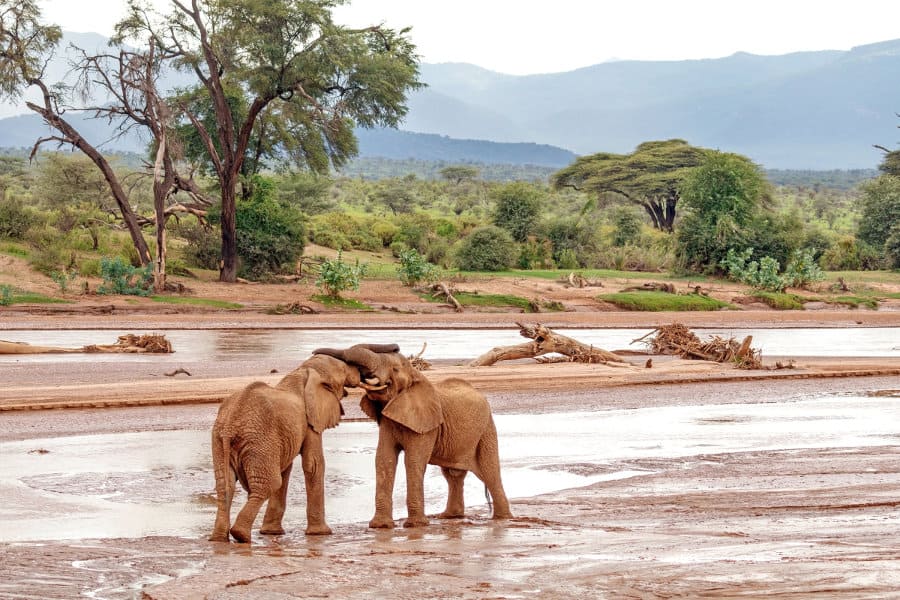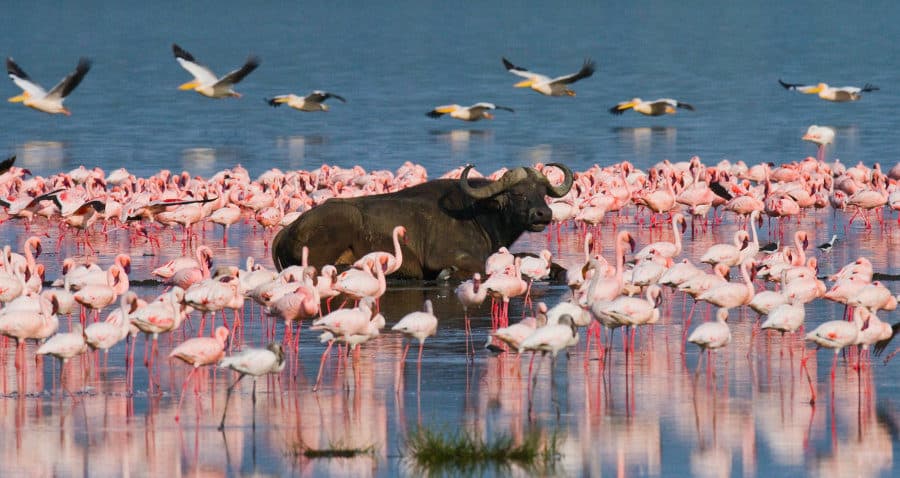From marshy forests and palm groves, amid dryland ecosystems and wild savannahs, Samburu National Reserve is one of Africa’s best safari destinations. It provides a haven for iconic wildlife and offers a spectacular safari experience.
The reserve is home to the rare northern Samburu Special 5 species. Captivating big cats prowl through thick acacia forest and tall yellow grass. And fascinating Samburu elephant herds saunter over this game reserve.
This region provides a diversity of wildlife and an awe-inspiring Kenyan safari experience. Here’s how to get the best out of your visit to the reserve.
Where is the Samburu National Reserve?
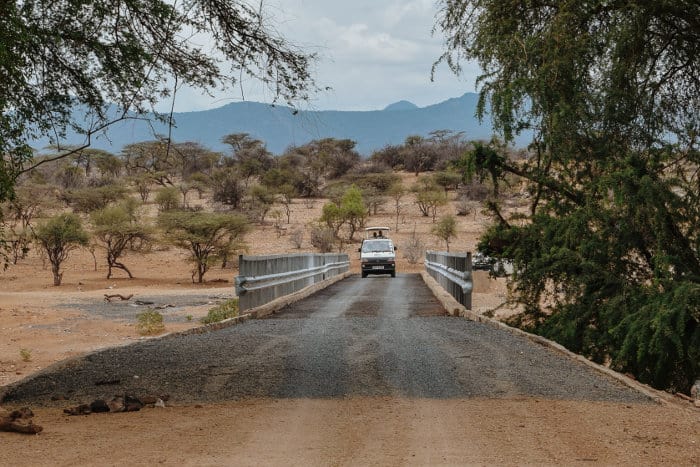
The Samburu National Reserve is in the North of Laikipia in Kenya. It’s a semi-desert park, located in the Rift Valley in Samburu district, central Kenya.
The reserve got its name from the Samburu tribe. These tribespeople rely on northern Kenya’s largest river, Ewaso Nyiro, to provide water for their crops and herds.
The reserve’s landscape consists of shrubby bushland and semi-arid savanna lands. It’s infringed with acacia and palm forests along the Ewaso Nyiro River.
Ewaso Nyiro River – Samburu’s Life Source
The plentiful wildlife that roams the reserve relies on the Ewaso Nyiro River. The river runs its course through three different reserves, namely the Shaba National Reserve, the Buffalo Springs National Reserve, and the Samburu National Reserve.
Hippos and crocodiles share the river and live in harmony together. They also share the river with herds of elephants who come to frolic in the muddy brown waters in the scorching heat of the day.
Top 5 Things to See & Do in Samburu National Park
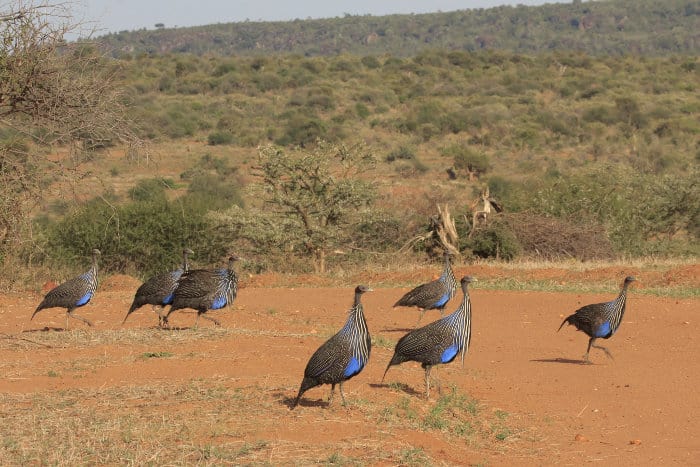
There are many attractions that provide an authentic wilderness experience in this reserve. Let’s take a look at 5 top things to see and do.
1. Stay in accommodation that can range from Bedouin-style tents to luxury lodges. Find yourself sleeping in game lodges around volcanic rock faces or in tents surrounded by animals.
2. Learn about the Samburu tribes’ nomadic way of life.
3. Spot the Samburu Special 5 species. The gerenuk, beisa oryx, reticulated giraffe, Somali ostrich, and the Grévy’s zebra.
4. There are 450 bird species recorded in the reserve. Try to spot some of them, including the vulturine guineafowl and kori bustards.
5. Be inspired by the real-life tale of a lioness adopting and protecting an orphaned gazelle. Read the full story as you enter the Samburu National Reserve.
5 Reasons to Visit Samburu National Reserve in Kenya
Samburu is the second-most visited game reserve in Kenya, after the Masai Mara Reserve. Let’s take a look at some reasons to visit this astounding reserve.
1. Guided tours and safaris
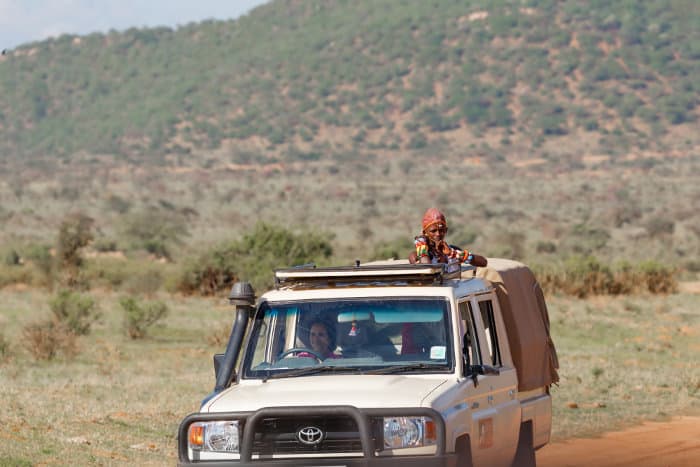
The Samburu National Reserve offers 165-square kilometers of the country to explore.
The reserve has a diversity of flora and fauna, along with unrestricted access to rugged East African wilderness.
Game drives often follow along winding, sandy tracks close to the meandering river. Spot plenty of wildlife along the road during your bush trip to Kenya. From prides of lions to a flight of graceful, springing impala or a herd of elephants.
There is a range of other safari activities to enjoy as well, such as the big cat tracking at Saruni Samburu. Enjoy bush breakfasts at Elephant Bedroom Samburu Camp and explore the landscapes on a camelback safari.
Tip: Before booking your safari, consider what will best suit your needs. Game drives try to cater to everyone from large groups, private bookings, or families.
2. It’s a bird-watching haven
You’re unlikely to miss flocks of helmeted and vulturine guineafowl. Large birds of prey are also spotted, such as the martial eagle and pygmy falcon. Smaller birds found at the reserve are bustards, weavers, shrikes, woodpeckers, and flycatchers, to name a few.
Try spot the blue-skinned male Somali ostrich. During the mating season, the males offer a feathery dance to win the females over.
3. It’s home to big game
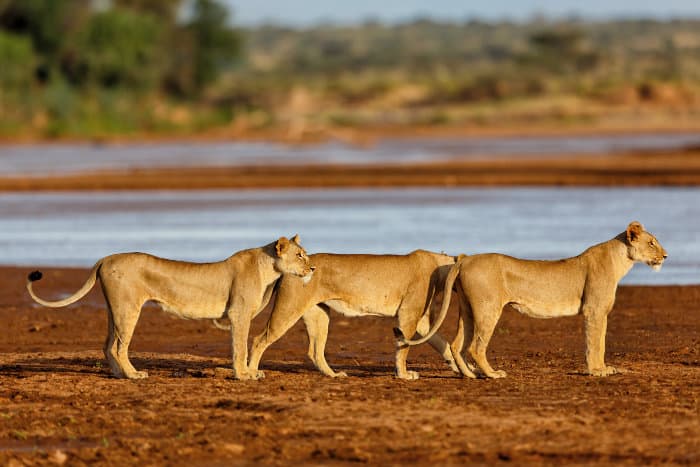
Samburu’s forests and savannas are home to a diverse range of big game. This includes big cats such as leopards and lions, endangered African wild dogs, and a large number of elephants.
4. You can spot the Samburu Special 5
While the Masai Mara boasts the famous Wildebeest Migration, and the Amboseli has captivating herds of elephants, the Samburu has the Special 5 (family to the world-famous Big 5).
5. It’s home to the nomadic Samburu tribe

During your stay at the reserve, you can meet the nomadic Samburu tribe. They are pastoralists and move from one place to another.
As nomadic people, they follow the patterns of rainfall that provide fresh pastures and a source of water for their livestock.
The Samburu tribe wear brightly colored traditional attire. The women drape themselves in beaded jewelry and necklaces.
Samburu Special 5
We’ve mentioned how Samburu has its own unique group of animals, known as the Special 5. Let’s meet each animal below.
Giraffe gazelle or gerenuk
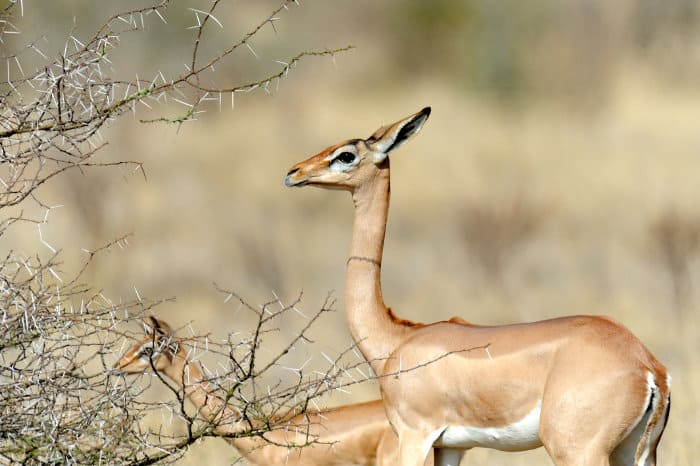
The name gerenuk means ‘giraffe-necked’ in the Somali language. These gazelles do indeed have chucklesome long necks. To add to their caricatured physique, they have rather large ears compared to their cute small heads.
These humble creatures have strong hind legs used for standing on for long periods while grazing on high unreached leaves.
Did you know – These fascinating gazelles do not need to drink water? It is a mere option for them. In fact, they can go without drinking water their entire lives! Instead, they get most of their water intake from the succulents they eat.
Somali ostrich
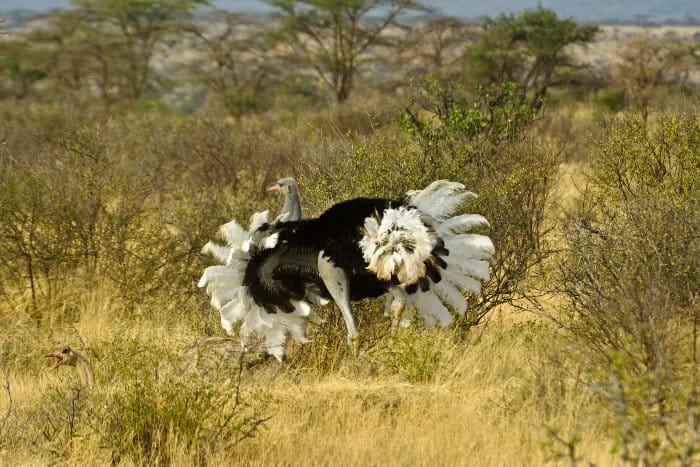
Somali ostriches are recognizable from their grey-blue skin on their legs. This sets them apart from other common ostrich species with pink skin. During the mating season, their legs and necks turn bright blue; it’s an easy spot for the males!
Grevy’s zebra
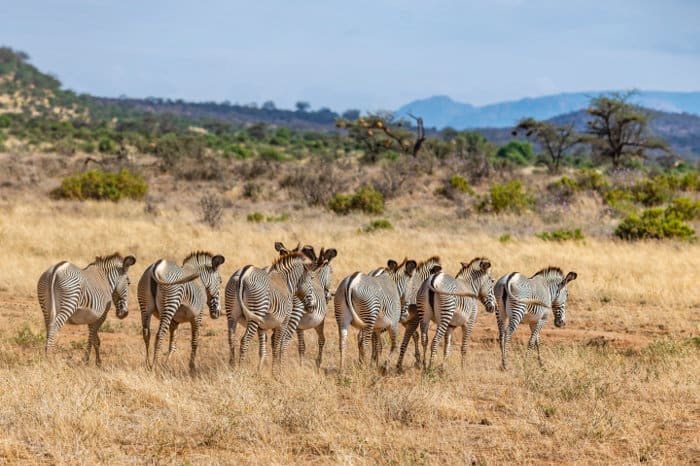
Also known as ‘imperial zebra’, they are the most endangered of all zebra species. With only 2,000 Grevy’s zebra left. These zebras can live without drinking water for up to five days. This allows them to be able to adapt to dry conditions.
They have black and white narrow stripes. Their round bellies and docks lack stripes like the more common zebra.
Beisa oryx
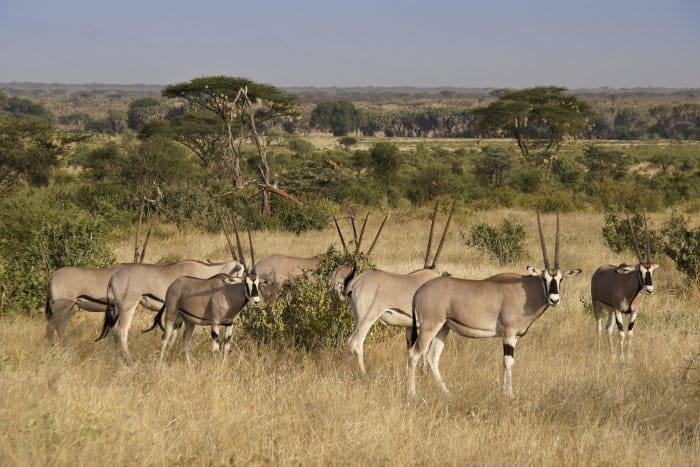
Both male and female beisa oryx grow scimitar-like horns that can reach up to a meter (three feet) in length. To win females’ favor, males will get into ferocious battles with their long, sharp horns. This usually occurs during the rutting season.
Every so often, you will spot a male with only one horn, the other lost during a fight.
Reticulated giraffe

Reticulated giraffes are native to Somalia, northern Kenya, and southern Ethiopia.
These giraffes are endangered, with only about 8,500 left in the world.
They are recognizable from their large, liver-colored shaped polygons on their hides. Their shapes are different from the lighter, smaller patches found on their southern cousins.
The Best Time of Year to Visit the Samburu National Reserve
Samburu welcomes visitors year-round. Daytime temperatures range from heat of 84 F (29 C) to 90 F (32 C) degrees. Whereas nighttime temperatures hit lows from 61 F (16 C) to 66 F (19 C) degrees, depending on the month.
The best time for game viewing is usually during the dry season, from June to October and December to March. During this time, animals gather at water sources, making it a glorious sight to see. Large numbers of elephants and predators flock to the Ewaso Nyiro River during this time too.
In the heart of the dry season, there is little to no rain and plenty of sunshine. Malaria during this time is virtually absent.
During peak rainy months (November, April, and May), there are still many animals around. Yet, getting to them could be difficult due to road conditions. This is, however, the best time for bird watching enthusiasts with the presence of migratory birds in abundance.
Where to Stay: Samburu Lodges and Tented Camps
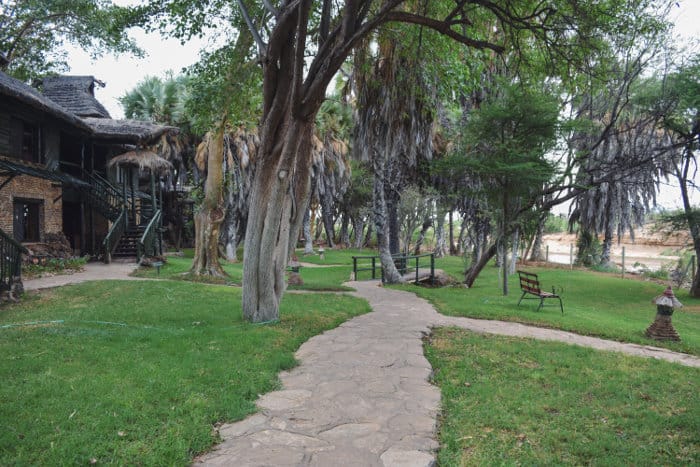
Samburu offers a range of accommodations, from stunning tented camps to luxury lodges. Some are family-friendly, and others are ideal for an off-the-beaten-path honeymoon.
You can pick from the assortment of accommodations offered in and around Samburu National Reserve.
The Elephant Bedroom Camp is an ideal choice for those looking to get a real authentic feel in a tented camp. The camp is in the very heart of the Samburu game reserve, getting its name from the regular herds of elephants that wander through the area.
Sasaab and Saruni Samburu lodges are just outside the reserve. These lodges offer luxury accommodation overlooking pristine, untouched landscapes.
Malaria & Safety in the National Park
Malaria is present in Kenya. You may consider taking antimalarials six weeks before your travel date.
Also, make use of other protections such as a good mosquito repellent.
Be mindful malaria is at its worst during the peak rainy season.
Plan Your Next Trip to the Samburu National Reserve
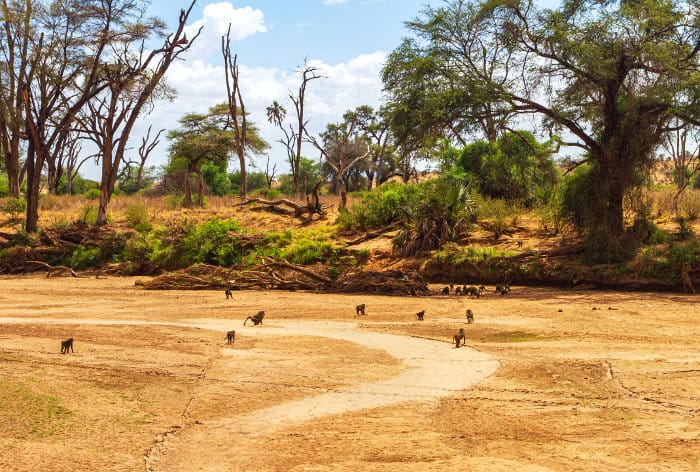
Discover the rich culture of the Samburu National Reserve. Take a unique safari tour on camel or horseback in its transverse desert terrain. Encounter a diversity of wildlife species in the semi-arid landscapes.
Look out for buffalo, herds of elephant, prides of lions, leopard, and cheetah.
See what separates Samburu Reserve from other parks in East Africa. Enjoy the magical view of the great Ololokwe mountain serving as the backdrop to the reserve. Termite mounds and weaver bird nests dot the landscape in the foreground. This reserve is something magnificent.
Get your cameras ready for captivating moments in the heart of Africa. Plan the ultimate African safari now.
